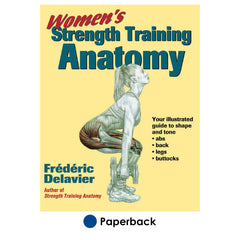Learn why women carry more fat than men
This is an excerpt from Women's Strength Training Anatomy by Frederic Delavier.
One of the main morphological differences between men and women is the greater amount of fat that women carry; this softens the outline of the muscles, more or less erases the osseous indicators, and rounds out the surfaces while creating characteristic folds and grooves.
Fat in normal women represents between 18% and 20% of body weight, whereas in men it represents only 10% to 15%. The reason for this difference is that women at some point in their lives may nourish a fetus and then a baby from their own reserves, so women have to stock energy in the form of fat in anticipation of future pregnancies (and must stock even more energy during the last two trimesters of pregnancy).
For various reasons, different fat distributions occur in women according to climate. In hot countries, the fat is localized on the buttocks (black Africans), on the hips (Mediterraneans), and around the navel (certain Asians). This distribution avoids covering the woman with a hot coat of fat that would be difficult to bear and inefficient for thermoregulation during hot periods. In cold countries, the distribution of fat is more uniform, which provides for better protection during rigorous winters. However the fat is distributed, its main function is for the survival of the species as it provides for survival of the woman and her offspring during times of scarcity.
It is important to note that all healthy people have fat reserves necessary for the proper functioning of their bodies. Obsession with obesity or the need to follow deviant aesthetic fashions should not lead to the complete elimination of fat. In fact, the almost complete disappearance of fat can lead to serious hormonal problems involving the cessation of the period (amenorrhea, which is a temporary absence of ovulation and therefore momentary sterility), as this means has been put in place during evolution to avoid bringing progeny into the world that the female could not nourish with her own organic reserves.
Primary Fat Deposits
Fat reserves accumulate in very specific areas on the body. Generally they avoid the flexion folds at the joints in order not to interfere with movement. Fat accumulations are often distributed the same in both sexes; the main difference is in the greater development on certain areas in women.
1. The Buttocks
The buttock region can be quite prominent in women; this is almost entirely due to fat that is contained by the gluteal fold. Besides its role as an energy reserve, this concentration protects the anal area and helps make the sitting position more comfortable by cushioning the direct contact between the bones (ischial tuberosities) and the ground or supporting surface.
The Gluteal Fold
The gluteal fold is made up of tough, fibrous tracts that connect the deep surface of the skin in the gluteal area to the ischium. The main consequence of this fibours attachement is to contain the fat in a sort of pocket, which prevents it from falling down against the back of the thigh while at the same time increasing the volume of the buttock. When certain people age, this fat empties and the bottom of the buttock withers, even going so far as to hang down. Only appropriate training of the buttock area will compensates for the disappearance of fat and the loss of tone through muscle development that maintains the buttocks from the inside.
2. Low Back
Second in importance, this concentration merges with the gluteal area so that the buttock increases in height until it seems to go up to the waist.
3. Below the Trochanter, or “Riding Breeches”
Frequently found in Mediterranean women, this concentration can be quite bulky. Located on the superior part of the lateral thigh just below the depression of the greater trochanter, it blends with the fatty tissue of the anterior surface of the thigh and, at the posterior, with that of the buttocks. When there is a lot of fat in this area we often observe many more or less deep depressions on the surface of the skin, referred to as a “pitted” or “cottage cheese” surface. This is due to inelastic fibrous tracts that, like little cables, connect the deep surface of the skin at the level of the depressions to the enveloping aponeurosis of the muscle, with the adipose tissue creating bumps or bulges in between (a quiltlike phenomenon).
4. Between the Thighs
Relatively common in women, fat in this location plays an important aesthetic role in that it fills the space between the two thighs; it is often more noticeable in women than in men.
5. Around the Navel
As in the subtrochanteric location, the periumbilical concentration is one of the rare fat deposits that is also found in thin women.
6. Pubis
This triangular concentration is known as the “mount of Venus.” It protects the symphysis pubis from blows.
7. Knee
In women, the knee is often a location of fat concentration, especially on the medial region.
8. Posterior-Medial Part of the Upper Arm
Especially developed in women, this concentration, besides its energetic role, protects the superficial nerves and arteries in the medial and superior area of the arm.
9. Breasts
The breast is composed of fat enclosing the mammary glands, the whole being held together by a web of connective tissue resting on the pectoralis major. Note that men also have glands and mammary fat (atrophied).


Get the latest insights with regular newsletters, plus periodic product information and special insider offers.
JOIN NOW


